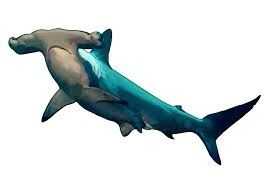Scalloped Hammerhead

Species Details
Sphyrna Lewini
Sphyrnidae
Carcharhiniformes
Inshore, Offshore
60 - 64 lbs.
59" - 169"
Scalloped Hammerhead (Sphyrna lewini ) Fish Description
Also known as southern hammerhead, kidney-headed shark, and bronze hammerhead, the Scalloped Hammerhead is a species of the Sphyrnidae family of hammerhead sharks. They are the sister species of the Carolina hammerhead (Sphyrna gilberti); they differ in terms of their number of vertebrae.
The Scalloped Hammerhead stands out due to the ��‘hammer’ on its head. It is a fairly large species of hammerhead sharks but smaller than the smooth hammerheads. Their bodies are greyish brown or light grey in color, fading to white below.
Diet
They have a very high metabolic rate so they need a lot of food. They generally feast on herring, mackerel, and sardines. They also feed on cephalopods like octopus and squid. Scalloped Hammerheads may also eat smaller species of sharks like the blacktip reef shark.
Their widely spaced eyes and nostrils (on top of their special senses) play a huge part in the capture of their prey. Additionally, their wide heads enable them to sense more accurately their victims, including those buried in the sand.
Size
Female Scalloped Hammerheads are generally larger than the males. The females can grow up to 98.4 inches and weigh 180 pounds, whereas the males measure only up to 70.8 inches and weigh 60 pounds.
Interesting Facts
- The Scalloped Hammerhead sharks can navigate the ocean with their homing device-like ability. They move during nighttime and use their surroundings as a map.
- Due to the shape of their heads, they can bury their heads into the sand and pin stingrays down. They possess special sensory cells that allow them to detect their prey using the electric fields that their victims give off.
- Sadly, the population of Scalloped Hammerheads has declined by 95% over the last three decades due to overfishing and the high demand for their shark fins and livers (for oil).
- They are so shy to the point that it is hard for scientists to study them; they pose minimal danger toward people despite having been accused of attacking some people before.
Scalloped Hammerhead — Fishing Techniques
The Scalloped Hammerheads are considered Critically Endangered on the IUCN Red List; thus, they currently enjoy protected status. The International Union for Conservation of Nature has suggested that anglers all over the world stop fishing this species. The decline in the population of this species is primarily attributed to bycatch and overfishing.
Habitat and Distribution
These sharks thrive in tropical coastal waters as deep as 1,600 feet all over the world. Since they are a coastal pelagic species of fish, they live in insular and continental shelves and deep areas of the ocean. During the day, the Scalloped Hammerhead swim close to the shore; at night, they hunt offshore. They used to travel in large schools but this made them vulnerable to target fishing; these days, they can be seen in pairs, in small schools, or alone.
The juveniles inhabit shallow coastal areas like mangroves and bays, sheltering them from predators. After around three years, the juvenile hammerheads would return to pelagic areas to feed.
They are located from New Jersey to Brazil including the Gulf of Mexico and the Caribbean Sea. They are also sighted in the Mediterranean Sea, the Red Sea, the Indian Ocean, and the eastern Pacific. They also swim in the waters of Ecuador, Peru, Japan, and Australia.







